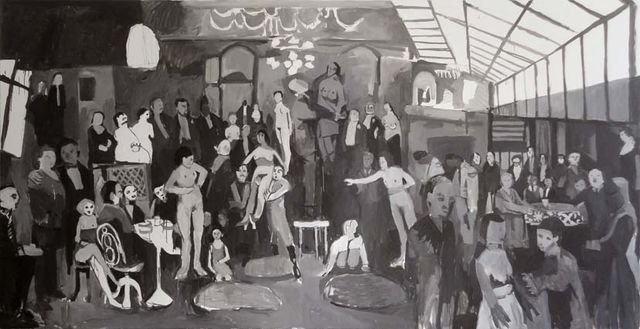
Helen Verhoeven (1974, NL) was awarded the Wolvecampprijs 2010 with her most recent series ‘The Thingly Character’.
In her monumental, epic series of paintings including 'Event' (2008), 'Half After' (2009) and her recent ‘The Thingly Character’ (2010) Verhoeven seems to explore the collective memory of ceremonial group meetings, within which a landscape of nightmares and ghostly apparitions is hidden.
'The Thingly Character’ expresses a burlesque, ‘Weimar-like’ world in which social values are abandoned and the realm of taboo is explored. Verhoeven is able to show suppressed emotions and tensions, which the group tries to camouflage. She pulls the cloth at unexpected moments to share a collective feeling of desperation; depicting scenes in which themes like power and powerlessness, guilt and innocence, submission, and dominance play a decisive role. In the psychologically charged world of Verhoeven, wealth and decadence meet a repressed desolation, dismantling any fixed notions of social stability.
Verhoeven deliberately chooses to incorporate art historical quotes referring to Hieronymus Bosch, Goya and De Chirico, among others. In addition, she appropriates material from family archives, newspapers, paparazzi pictures, and film, creating a complex series of paintings in which different times, visual languages, and psychological states collide.
Even Verhoeven's style of painting contributes to the feeling of discomfort that is evoked within her works. Her coarse naïve-like brush stroke seems to suggest that social behavior can be traced back to primitive, individual motives. For the first time, Verhoeven uses a palette consisting of black, white and gray hues. Stripped from its veneer, these colorless compositions seem to underscore the melancholic, to distill, to mute, and to create a certain distance from the viewer. Verhoeven's epic black and white scenes are reminiscent of the silent films of the '20s, but also of the grisaille underpainting of the old masters.